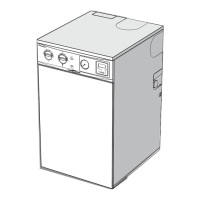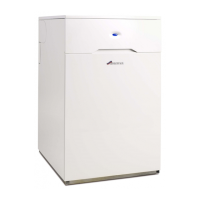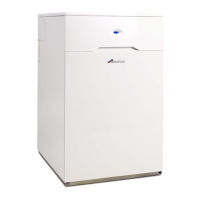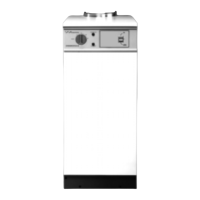turned off rapidly.
4. See section 12 for further details.
15.6 Oil supply installation.
(See Fig. 12 to 14).
NOTE: Never route the oil supply pipe/hose directly below the
combustion chamber base.
NOTE: Connection of rigid copper pipe to the oil pump is not
recommended. Connection to the oil pump should be made with
flexible oil hoses as shown in Fig. 14.
(a) Single pipe suction lift with de-aerator.
For connection of single pipe suction lift with de-aerator follow
the procedure as for a double pipe system described below.
(b) Double pipe system oil return pipe.
When fitting an RS balanced flue appliance follow 1 to 11. When
fitting a CF/LLD appliance follow step 1 and fit a bulkhead fitting
to the bracket for the return pipe and continue from step 10.
1. Remove the isolating valve bulkhead fitting by unscrewing
the locknut on the underside.
2. Remove the blind grommet from the fixed burner surround
box and discard.
3. Replace the blind grommet with the open grommet supplied
in the plastic bag.
4. Slacken the pipe retaining clip screw located directly below
the grommet hole. When using 12mm copper pipe replace the
clip with the larger one supplied.
5. Bend a piece of 10mm or 12mm copper tube (as selected) to
the correct profile to allow the pipe to be fed down the side of
the appliance. Make a slight chamfer on the end of the pipe to
be fed through the grommet to facilitate easy insertion.
6. Lubricate the grommet hole with vaseline (or butter etc.) and
slide the pipe through the hole, supporting the grommet on its
underside to prevent it dislodging.
7. Feed the pipe through the retaining clip, allowing
approximately 80mm of pipe to project beyond the clip, and
tighten the retaining screw. Take care not to overtighten the
screw!
8. Hold the pipe at the retaining clip and gently pull the pipe
forward sufficiently to allow a compression to
1
⁄4 inch BSP
female fitting to be fitted for connection to the oil return flexible
hose.
9. Connect the fitting to the pipe and fit a
1
⁄4 inch BSP taper
thread flexible hose, ensuring a good seal using PTFE tape or
suitable oil sealing compound. The flexible hose should have a
1
⁄4 inch BSP rotating union taper fitting at the other end with a
90 degree bend and
1
⁄4 inch BSP nipple for connection to the oil
pump.
10. Replace the isolating valve bulkhead fitting.
11. Fit the oil supply pipe as described in the following section.
(c) Single pipe system oil supply pipe.
1.
Bend a piece of 10mm or 12mm copper tube (as selected) to
the correct profile to allow the pipe to be fed down the side of
the appliance. The pipe may be routed either along the right or
left hand side of the boiler as required. When using 12mm pipe
fit a 12mm to 10mm compression coupling and connect to the
valve with a short piece of 10mm pipe, otherwise connect
directly to the valve.
NOTE: Never use soldered joints on the oil supply pipes as this
could cause a hazard in the case of a fire.
2. Route the pipe back to the oil supply tank ensuring that it is
hard against the boiler, to allow installation of the side panel.
3. With the isolating valve in the correct orientation tighten the
back-nut.
4. Turn the isolating cock fully clockwise to close the valve.
5. Open the main oil supply valve at the tank and check for any
leaks.
6. Place a suitable container below the bulkhead fitting and
open the valve.
7. Draw off at least 2.5 litres of oil until a steady flow of clear
uncontaminated oil can be seen and turn off the isolating valve.
NOTE: This method may not be possible on some installations
where a sub-gravity system used. Where the problem arises
bleed the system using the oil pump as described in Section 16
and remove and clean the oil pump filter to remove any debris
collected as result of installation.
15.7 Replace the electrical control panel and side panels in
reverse order to the removal procedure of Section 5 and connect
the electrical supply as described in Section 13.
Ensure that no foreign matter is left in the system as this could
cause damage to the appliance.
Check that the electrical supply to the appliance is switched off.
Benchmark Water Treatment: For optimum performance
after installation, this boiler and its associated central
heating system should be flushed in accordance with the
guidelines given in BS7593:1992 - Treatment of water in
domestic hot water systems. Full instructions are supplied
with proprietary cleansers sold for this purpose. If an
inhibitor is to be used after flushing, it should be used in
accordance with the inhibitor manufacturers instructions.
Suitable flushing agents and inhibitors are available from
Betz Dearborn Tel: 0151 4209563 and Fernox Tel: 01799
550811.
Instructions for use are supplied with these products.
IMPORTANT: Any system cleanser must be flushed from the system
before an inhibitor is added.
16.1 Domestic Hot Water System
Check that the mains water supply has been fully flushed out at
installation.
16.2 When commissioning the appliance after initial installation
follow the procedure from 16.3, otherwise remove the burner
first as described in Section 18.3.
16.3 Appliance and System Preparation
1.
After initial installation and checking for leaks, as previously
described, drain down the system sufficiently to add a flushing
agent.
2. Fill the system using one of the methods described in Section
10, adding a suitable corrosion inhibitor in accordance with
BS7593.
3. Check that the pressure relief valve operates by turning the
knob anti-clockwise until water is expelled from the discharge pipe.
4. Set the Expansion Vessel Pressure
The charge pressure of the expansion vessel as despatched is
0.5 bar, which is equivalent to a static head of 5 metres (16.7
ft.). The charge pressure must not be less than the static head at
the point of connection. See Figs 15 and 16. A Schraider type
tyre valve is fitted to the expansion vessel to allow the charge
pressure to be increased if necessary.
5. Set the System Pressure
Fill the system until the pressure gauge shows 1.5 bar (21.5
lb./in
2
) and check for water soundness. Release water from the
system, using the pressure relief valve knob, until the System
Design Pressure is obtained, up to a maximum of 1.5 bar.
System Design Pressure in bar = Static Head of the System in
bar + 0.3.
NOTE: 1 bar is equivalent to 10.2 metres (33.5 ft) of water. Set
the movable pointer giving a permanent record of the set
system pressure.
If the pressure indicated on the pressure gauge is greater than
2.5 bar when operating at the maximum central heating
temperature, an extra expansion vessel must be fitted to the
system as close as possible to the appliance central heating
return connection. Refer to Section 10 for further information on
system capacities.
16. Commissioning the Appliance
28

